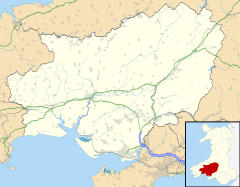
Back Brynaman Breton Brynamman CEB Brynamman Czech Brynaman Welsh Brynamman Spanish Brynamman Basque براینامان Persian Brynaman Finnish Brynamman Dutch Brynamman Swedish
Brynamman
| |
|---|---|
Location within Carmarthenshire | |
| Population | 2,608 |
| Community | |
| Principal area | |
| Preserved county | |
| Country | Wales |
| Sovereign state | United Kingdom |
| Post town | AMMANFORD |
| Postcode district | SA18 |
| Dialling code | 01269 |
| Police | Dyfed-Powys |
| Fire | Mid and West Wales |
| Ambulance | Welsh |
| UK Parliament | |
| Senedd Cymru – Welsh Parliament | |
Brynamman (Welsh: Brynaman) is a village on the south side of the Black Mountain (Y Mynydd Du), part of the Brecon Beacons National Park (Parc Cenedlaethol Bannau Brycheiniog). The village is split into Upper Brynamman and Lower Brynamman by the River Amman, which is also the boundary between the counties of Carmarthenshire and Neath Port Talbot (in the old county of Glamorganshire). Ruins of stone dwellings (possibly prehistoric), an early type of lime kiln and rectangular medieval buildings found on the mountain show that people have lived in this area for a long time. The population of Brynamman was 2,608 as of 2011; the urban area including Gwaun-Cae-Gurwen was 5,692.[1][2]
Brynamman was previously known as Y Gwter Fawr (Welsh: "The Big Gutter"); The name was changed when the railway from Ammanford reached the village. George Borrow describes aspects of Gwter Fawr in the mid-19th century in his book Wild Wales published 1862. The current name is derived from "Brynamman House", the home of John Jones, builder of the railway.[citation needed]
Brynamman Golf Club (now defunct) first appeared in the mid-1920s. It continued into the 1930s.[3] A feasibility study is being conducted into the reopening of Brynamman Lido, which opened in 1934 and closed in 2010.[4]
- ^ "Custom report - Nomis - Official Labour Market Statistics".
- ^ "Custom report - Nomis - Official Labour Market Statistics".
- ^ "Brynamman Golf Club", "Golf’s Missing Links".
- ^ Harries, Robert (16 October 2022). "The historic Welsh lido left in ruin that may finally get its chance to shine once more". Wales Online. Retrieved 16 October 2022.
